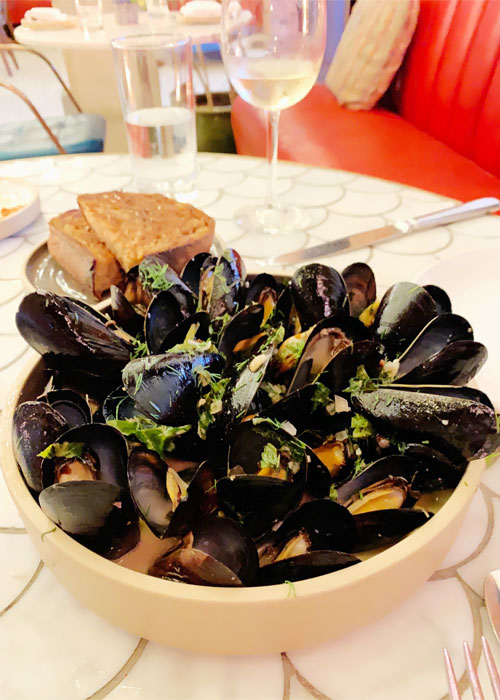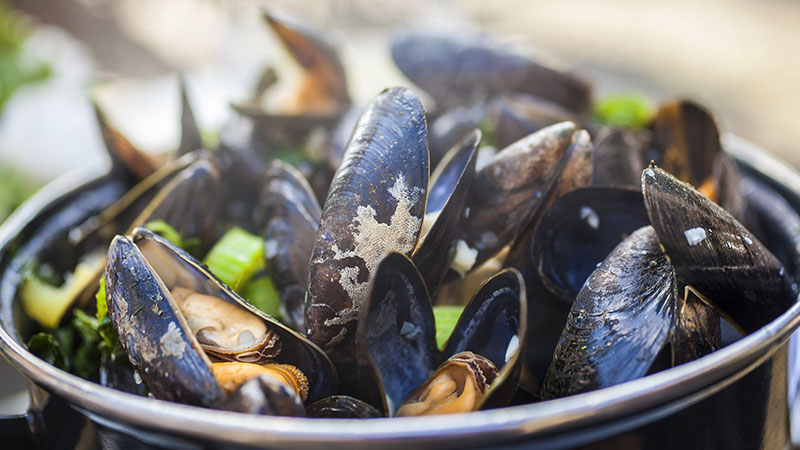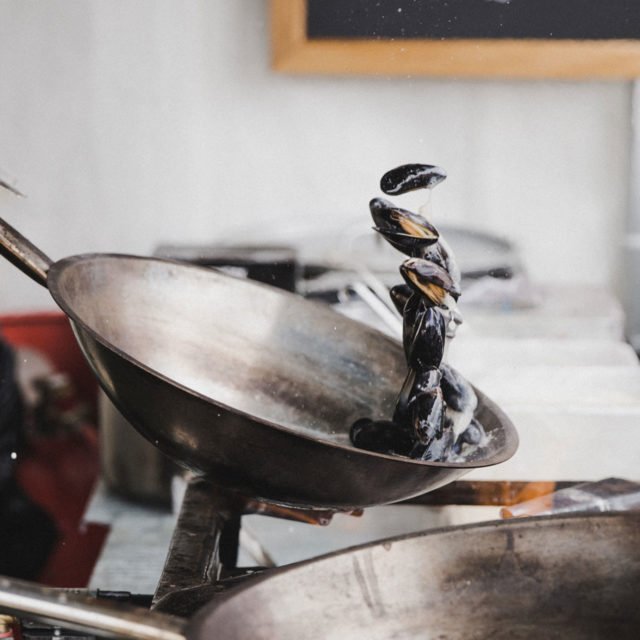“Mussels are amazing because they take on the flavor of whatever sauce they’re prepared in,” Alexandra Shapiro, owner of Manhattan eatery Flex Mussels, says. “They’re not overpowered by flavor, they’re enhanced by it.”
Shapiro speaks with authority on the topic. Flex sells one and a half tons of the mollusk every week and offers 23 different mussels dishes. The restaurant’s “Classic” preparation is inspired by the traditional French method of cooking mussels, moules marinières, which sees them steamed with finely diced shallots, garlic, thyme, and white wine.
Moules marinières might not strike most home cooks as an easy undertaking, but the dish calls for considerably less effort than a lasagne and cooks in a fraction of the time of mac and cheese.
When buying mussels, they should smell fresh like the ocean and their shells should be tightly closed. Unlike some other seafoods, farm-raised mussels are actually more favorable than their wild counterparts as they’re much cleaner when you buy them, they’re sustainable and help clean the waters they’re grown in, and they’re available all year round.
The bulk of the effort involved in preparing moules marinières comes before any pan hits the stove, during the cleaning of the ingredient. Broken shells should be discarded, while open mussels should be tapped sharply to make them close. Shells that are open and won’t shut indicate the mussel is dead and must not be cooked — you don’t want to make your dining companions sick, after all.
The live, undamaged mussels should be soaked in a sink filled with ice-cold water and scrubbed clean with a sponge to remove grit and dirt. A small paring knife can also be used to remove the fibrous “beards” that sometimes emerge from the inside of the shell. Once clean, all mussels should be lifted out of the water before the sink is drained.
A heavy-duty pan with a close-fitting lid is essential for cooking moules marinières. Its thick base will maintain the high temperatures required, while the lid locks in steam, cooking the meat and opening the shells in the process. An open shell signals the mussel is cooked, while any that remain closed after considerable cooking time should be discarded.
White wine is the most common alcohol used to cook the dish, but chefs use a number of different beverages to impart a range of interesting flavors.
At Monk’s Cafe, a legendary beer bar in Philadelphia, chef Keith Ballew adds a Belgian flair to his menu, incorporating beer into almost all of his entrees. Five different mussel preparations utilize a number of styles of beer, including Flemish sour ales, geuzes, and Belgian saisons.
“I like the nuances of beer because you can add a ton more flavor to the dish, especially if the brewer is using herbs in their beer, or fruit, or different types of malt,” he says. “We try not to do a lot of hoppy beers, though, as they tend to get bitter as they cook down.”
In Normandy, chefs prepare moules à la normande using guzzles of hard cider. Diced fresh apples, on the other hand, can impart “acidity, softness, and sweetness,” according to Michelin-starred French-Belgian chef Raphael Francois. “I’m crazy about garlic, too, to the point where I don’t care if I smell of it,” he says. “When my mussels are ready, I add smashed garlic and toss it just a little bit, without cooking.”

In Brooklyn, at Lebanese-inspired Seven Seeds, chef Melissa O’Donnell fuses classical cooking techniques with her love of Lebanese cuisine. For her mussels dish, she includes arak, an aniseed-infused Middle Eastern distillate that tastes similar to pastis. (French chefs regularly add pastis to seafood sauces and stews.)
O’Donnell cautions against using too much arak, as its flavor can become overpowering. To bring balance, she suggests mixing it with white wine, in a two-to-one ratio of wine to arak. The resulting sauce is rich and flavorsome, with a notable aniseed kick that pairs perfectly with the salty, ocean-flavored mollusk.
Whether you’re using wine, beer, hard cider, or a little-known spirit, when it comes to side dishes, there are only two choices: bread or fries (à la Belgian moules frites).
A hearty wedge of sourdough is perfect “to suck up the juice,” O’Donnell says, while the tangy bread adds an extra layer of flavor. For Francois, however, nothing compares to the combination of mussels and hand-cut fries — though only after they’ve been dunked in the cooking liquor. Shapiro agrees and says, “Not doing that is a huge missed opportunity.”
For drinks pairings, most point to crisp, coastal whites, such as French Muscadet or Galician Albariño, as mussels’ perfect match. Others, including Shapiro, urge against overthinking it. “I’m a big fan of drinking what you want to drink,” she says. “Stop worrying about what the food world considers to be the ‘right thing to do’ and drink what you’re going to enjoy.”

Moules Marinières Recipe
Serves 2
Ingredients
- 2 tablespoons olive oil
- 2 shallots, finely diced
- 2 cloves garlic, minced
- ¼ bunch thyme, leaves picked and chopped
- 2 ½ pounds mussels, cleaned (see above)
- 250 milliliters white wine, e.g. Muscadet
- ¼ bunch parsley, leaves picked and chopped
- 2 tablespoons unsalted butter
- Salt and pepper, to taste
Directions
- Heat the oil in a large cast-iron pan and add finely diced shallots, garlic, and thyme. Gently sweat the ingredients until they become translucent (around 2 minutes).
- Increase the heat to high and add the mussels. Cover with a lid, and cook for 1 more minute.
- Before the shallots and garlic start to burn, add white wine and continue to cook with the lid on until you can hear the first shells begin to open (around 5 to 10 minutes). If you’re unsure, quickly lift off the lid and take a peak.
- Remove from the heat and keep covered for 5 more minutes. During this time, the remaining mussels will open.
- Stir in butter and chopped fresh parsley.
- Season with salt and pepper and serve with a doorstep-sized wedge of sourdough or freshly cooked hand-cut fries.
